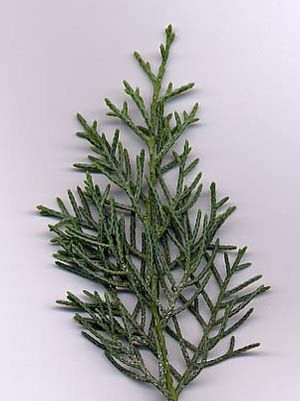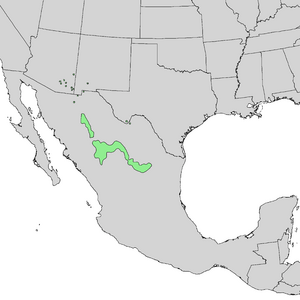Arizona cypress facts for kids
Quick facts for kids Arizona cypress |
|
|---|---|
 |
|
| Cupressus arizonica var. glabra (smooth Arizona cypress) foliage | |
| Conservation status | |
| Scientific classification | |
| Genus: |
Cupressus
|
| Species: |
arizonica
|
 |
|
| Natural range of Cupressus arizonica. Does not show populations in central Arizona. | |
| Synonyms | |
|
Synonymy
Callitropsis arizonica (Greene) D.P.Little
Hesperocyparis arizonica (Greene) Bartel Hesperocyparis revealiana (Silba) Silba Neocupressus arizonica (Greene) de Laub. Callitropsis glabra (Sudw.) Carrière Cupressus glabra Sudw. Hesperocyparis glabra (Sudw.) Bartel Callitropsis montana (Wiggins) D.P.Little Cupressus montana Wiggins Hesperocyparis montana (Wiggins) Bartel Callitropsis nevadensis (Abrams) D.P.Little Cupressus nevadensis Abrams Hesperocyparis nevadensis (Abrams) Bartel Callitropsis stephensonii (C.B.Wolf) D.P.Little Cupressus stephensonii C.B.Wolf Hesperocyparis stephensonii (C.B.Wolf) Bartel |
|
The Arizona cypress (scientific name: Cupressus arizonica) is a type of tree. It belongs to the cypress family. These trees are originally from the southwestern United States and Mexico.
You won't usually find them in huge, thick forests. Instead, they often grow in small groups spread out over an area.
Contents
What is the Arizona Cypress?
The Arizona cypress is an evergreen tree. This means it keeps its leaves all year round. It is also a conifer, which means it grows cones instead of flowers.
These trees have a shape like a cone or an egg. They can grow quite tall, usually between 10 to 25 meters (about 33 to 82 feet). Their trunks can be about 55 centimeters (22 inches) wide.
The leaves are small and flat, like scales. They are about 2 to 5 millimeters long. The leaves grow in thick bunches. Their color can be a dull gray-green or a bright blue-green.
Cones and Seeds
The seed cones are round or oval-shaped. They are about 15 to 33 millimeters long. Each cone has 6 or 8 scales, but sometimes 4 or 10.
When they first grow, the cones are green. After about 20 to 24 months, they turn gray or gray-brown. These cones stay closed for many years. They only open when the branch they are on dies. This often happens during a wildfire. When the cones open, the seeds fall out. This helps new trees grow in the bare ground left by the fire.
Male cones are smaller, about 3 to 5 millimeters long. They release pollen in February or March.
Different Kinds of Arizona Cypress
Some scientists believe there are different types, or varieties, of the Arizona cypress. Sometimes, these varieties are even seen as separate species. Here are some of them:
- Cupressus arizonica var. arizonica: This is the Arizona Cypress itself. It is doing well. You can find it in southern Arizona, southwest New Mexico, and parts of Mexico.
- Cupressus arizonica var. glabra: This is called the Smooth Arizona cypress. It is also doing well. It grows in central Arizona.
- Cupressus arizonica var. montana (also known as C. montana): This is the San Pedro Martir cypress. It is considered Vulnerable. This means it needs some protection. It lives in the mountains of Northern Baja California, Mexico.
- Cupressus arizonica var. nevadensis (also known as C. nevadensis): This is the Piute cypress. It is doing well. It grows in southern California.
- Cupressus arizonica var. stephensonii: This is the Cuyamaca cypress. It is Critically endangered. This means it is very rare and needs a lot of help to survive. It is found in southern California.
Most of the Cuyamaca cypress trees were burned in a large fire called the Cedar Fire in 2003. However, new trees have grown back well since then. This is expected for a tree that relies on fire to spread its seeds.
Where Does It Grow?
The Arizona cypress grows mainly in the southwestern United States. You can find it in Arizona, Utah, southwestern New Mexico, and southern California. There are also some groups of these trees in southern Nevada and in the Chisos Mountains of western Texas.
In Mexico, it grows in several states. These include Coahuila, Nuevo León, Chihuahua, Sonora, Durango, Tamaulipas, Zacatecas, and northern Baja California.
In nature, these trees often grow in small, spread-out groups. They don't usually form huge, dense forests. For example, in the Sierra Juárez and San Pedro Mártir pine-oak forests in Mexico, it grows alongside other trees like canyon live oak and California fan palm.
Why is it Important?
The Arizona cypress is often planted as an ornamental tree. This means people grow it in gardens and parks because it looks nice. The glabra variety, with its bright blue-green color, is especially popular.
This tree is very good at resisting a disease called cypress canker. This disease is caused by a fungus. Other cypress trees, like the Monterey cypress, are not as strong against it. So, the Arizona cypress is a reliable choice where this disease is common.
A special type of Arizona cypress, called 'Pyramidalis', has won an award. It received the Royal Horticultural Society's Award of Garden Merit in 2017. This award recognizes plants that are excellent for gardening.
See also
 In Spanish: Ciprés de Arizona para niños
In Spanish: Ciprés de Arizona para niños


